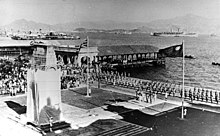History of banking in Hong Kong

The history of banking in Hong Kong refers to the chronological account and development of financial institutions in the region from its early days to the present.
19th century[edit]

British colonial influence[edit]
After the establishment of Hong Kong as a British colony in 1842, the territory witnessed the foundation of its modern banking system.[1] The Hongkong and Shanghai Banking Corporation (HSBC) was established in 1865, with the primary purpose of financing trade between China and Europe.[2][3]
Growth of local banking[edit]
By the latter part of the 19th century, apart from international banks, there was a significant emergence of local Chinese banks. These banks primarily served the financial needs of the local population and played a pivotal role in nurturing the domestic economy.[4][5]
Early 20th century[edit]
Economic volatility[edit]
The early decades of the 20th century were marked by economic uncertainties worldwide, which also influenced Hong Kong's trade-dependent banking landscape. The Great Depression, in particular, had a significant impact on banking operations and trade finance.[6] Throughout the early 20th century, Hong Kong faced various financial pressures, not just from global events like the Great Depression, but also due to regional disruptions caused by events such as the Chinese Civil War. These challenges required banks in Hong Kong to adopt adaptable business models and strategies, ensuring their survival.[7]
Development of regulatory framework[edit]
New rules and regulations were introduced by Hong Kong authorities to oversee banking operations. By the mid-20th century, initiatives were introduced to supervise lending practices, manage risks, and ensure the overall soundness of the financial institutions operating in the territory. Among the new measures were deposit insurance schemes, periodic financial health checks for banks, and stricter audit requirements.[7]
Post-war era[edit]

Post-war recovery[edit]
Following World War II, Hong Kong's banking sector played a central role in the region's post-war recovery, financing reconstruction and trade. In the wake of World War II, Hong Kong faced the massive task of rebuilding its infrastructure and economy. The banking sector was pivotal in this recovery phase, offering loans for reconstruction efforts and promoting trade activities, thereby setting the stage for Hong Kong's subsequent growth.[8]
Emergence as a financial hub[edit]
By the 1970s, with the rise of global finance, Hong Kong began to incorporate into the global economy as one of the world's leading financial centers. This era saw the introduction of more foreign banks and the expansion of existing local banks. The banking industry capitalized on this momentum, positioning itself to service global corporations, investors, and facilitating capital flow across borders and numerous jurisdictions.[9]
Late 20th century to present[edit]

Banking reforms[edit]
With an increasing emphasis on transparency and international standards, the late 20th century witnessed a series of banking reforms aimed at strengthening Hong Kong's position in the global finance arena. Among the reforms were improved disclosure practices and capital adequacy requirements.[10]
Financial crises and resilience[edit]
The Asian Financial Crisis of 1997-1998 and the Global Financial Crisis of 2008 were some of the most significant recent challenges for Hong Kong's banking sector.[7] Regulatory oversight and interventions played a significant role in stabilizing of the banking sector during the global economic upheavals.[11]
Digital banking and fintech[edit]
In the 21st century, digital banking and fintech innovations began reshaping the banking landscape in Hong Kong. Traditional banks expanded their services to include digital platforms, while new digital-only banks emerged. These developments reflected a broader trend in the banking industry's adaptation to technological advancements.[7]
See also[edit]
References[edit]
- ^ Coates, Austin (2009). Macao and the British, 1637 - 1842: prelude to Hong Kong. Echoes. Hong Kong: Hong Kong Univ. Press. ISBN 978-962-209-075-0.
- ^ Chiu, Peter (2003-04-15). "Hong Kong's Banking Industry Facing Keen Competition". China Perspectives. 2003 (2). doi:10.4000/chinaperspectives.260. ISSN 2070-3449.
- ^ Collis, Maurice (1965). Wayfoong: the Hongkong and Shanghai Banking Corporation (1st ed.). Faber and Faber.
- ^ latter, tony (2008). "Profits, politics and panics: Hong Kong's banks and the making of a miracle economy, 1935-1985 - By Leo F. Goodstadt". The Economic History Review. 61 (4): 1036–1037. doi:10.1111/j.1468-0289.2008.00447_31.x. ISSN 0013-0117.
- ^ Depeyrot, G. (2013). ocuments and Studies on 19th c. Monetary History, Hong Kong, Rise and fall of the Hong Kong Mint (7 May 1866 – 25 April 1868).
- ^ Cheung, Peter T. Y. (2011-08-01). "Who's Influencing Whom? Exploring the Influence of Hong Kong on Politics and Governance in China". Asian Survey. 51 (4): 713–738. doi:10.1525/as.2011.51.4.713. ISSN 0004-4687.
- ^ a b c d Wang, Hongying (1999). "Hong Kong and Globalization". Asian Perspective. 23 (4): 143–165. ISSN 0258-9184.
- ^ Jao, Y. C. (1974). Banking and Currency in Hong Kong: A Study of Postwar Financial Development. Palgrave Macmillan. ISBN 978-1349022014.
- ^ Lui, Tai-Lok. Hong Kong as a Global Business and Financial Hub. Navigating the Turbulence and Challenges (1st ed.). ISBN 9781032515953.
- ^ Rangarajan, Chakravarthi (2000). Structural reforms in industry, banking and finance: a case study of India (1. publ ed.). Singapore: Institute of Southeast Asian Studies. ISBN 978-981-230-109-3.
- ^ Jao, Y. C.; Jao, Yu-ching (2001). The Asian financial crisis and the ordeal of Hong Kong (1. publ ed.). Westport, Conn.: Quorum Books. ISBN 978-1-56720-447-6.
